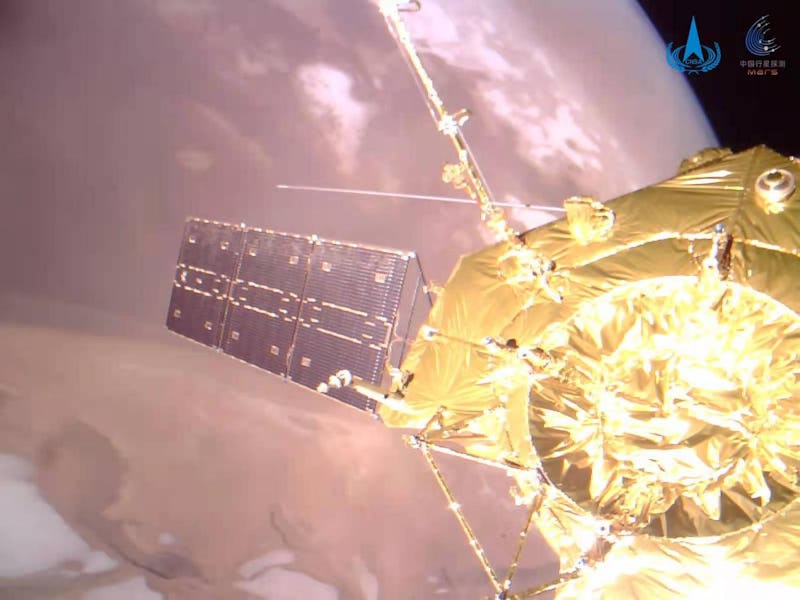Look: China's Mars orbiter captured a rare selfie with the Red Planet
Tianwen-1 Mars orbiter captured a rare image of itself with Mars in the backdrop.

It’s the little orbiter that could, and did, take a selfie with a planet in the background.
China’s Tianwen-1 Mars mission snapped an image of its orbiter against the backdrop of the Red Planet. China National Space Administration (CNSA) released these new images on Saturday, offering a stunning first view of a spacecraft in orbit around another planet.
This rare selfie is like no other, showing an orbiter around another planet.
Tianwen-1’s first image shows the orbiter’s shiny, gold orbiter flying above Mars’ north pole. Meanwhile, a second image shows a close-up view above the planet’s northern ice cap.
The orbiter can be seen along with its solar array and antennas.
A small camera captured the rare selfie, which the CNSA deployed from the orbiter specifically for these must-have interplanetary photo ops. It snapped the flattering photos of the Tianwen-1 orbiter while floating through space. The camera then sent over the images to the spacecraft through a simple WiFi connection, and the spacecraft beamed them down to CNSA mission control on Earth.
Where is Tianwen-1 now?
Tianwen-1 has been orbiting Mars for nearly a year now.
China’s first interplanetary mission entered Martian orbit on February 10, 2021.
The orbiter’s current path gets it as close as 174 miles to Mars and as far as 36,660 miles. The spacecraft completes one lap around the Red Planet roughly every two days.
The mission’s rover, named Zhurong, landed on Mars in May and has roamed the Martian terrain for 225 Martian sols. The solar-powered rover has driven slowly at 200 meters per hour for a total of 4,593 feet across Mars. It has six wheels and weighs about 530 pounds, about a quarter of the SUV-sized Perseverance rover.
CNSA uses the orbiter for communications between the rover and mission control.
What is the purpose of Tianwen-1?
The Tianwen-1 mission is China’s first successful interplanetary mission after the failure of the Yinghuo mission.
The name Tianwen comes from a poem written by Qu Yuan, a Chinese poet who lived from about 340-278 BC, and it roughly translates to “question to heaven,” or “quest for heavenly truth.”
So far, only NASA has successfully landed and operated a spacecraft on the surface of Mars.
But China’s Tianwen-1 is tasked with solving one of the biggest mysteries surrounding Mars — its ancient water. Scientists have been trying to reconstruct the early history of Mars to find out what happened to its water and answer questions about its habitability.
The Zhurong rover will look for water underneath the Martian surface that any form of life could potentially have lived within. It will also look for evidence of Mars’ past climate on the surface.
The rover has six science instruments designed to study the topography, geology, soil structure, minerals, rocks, and atmosphere of Mars.
Tianwen-1 was the second of three space missions targeted towards Mars that all launched during the July 2020 Mars launch window. The other two were NASA’s Perseverance rover, which landed on Mars on February 18, 2021, and the United Arab Emirates Hope orbiter, which entered Martian orbit on February 9, 2021.
All three missions will collect different pieces of evidence from the Red Planet, helping scientists paint a complete picture of the history of Mars and the possible habitability of its past.